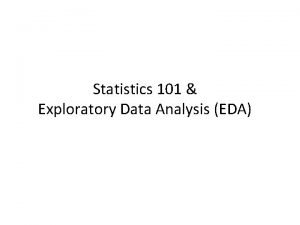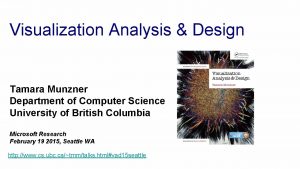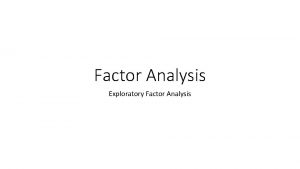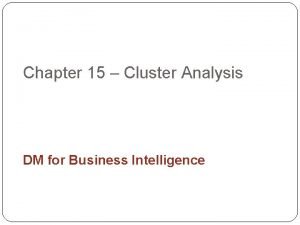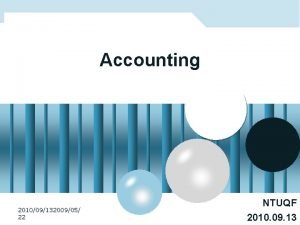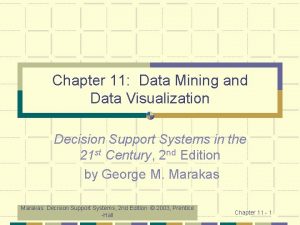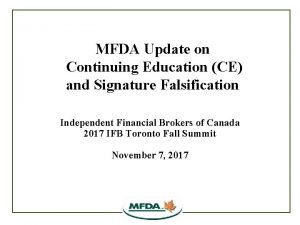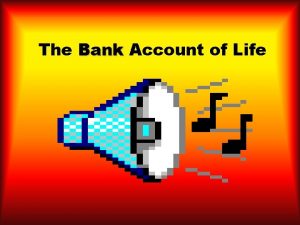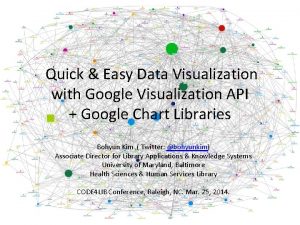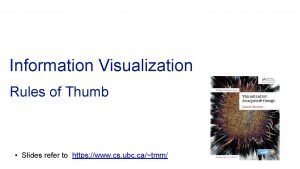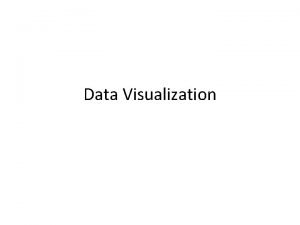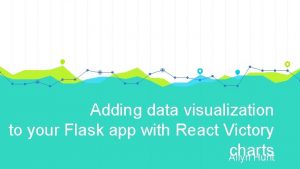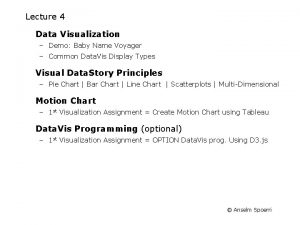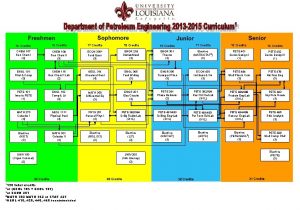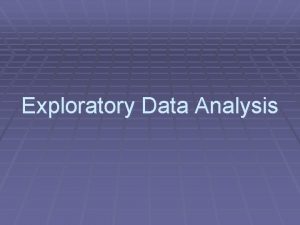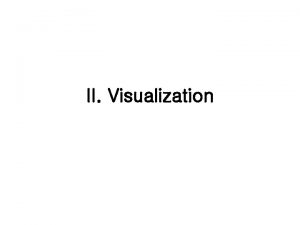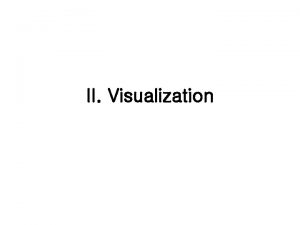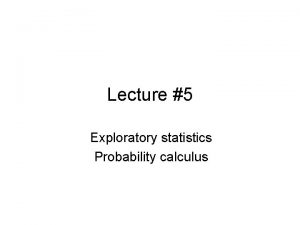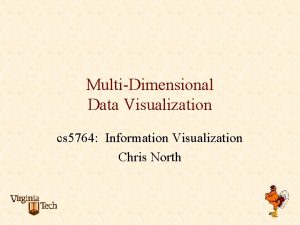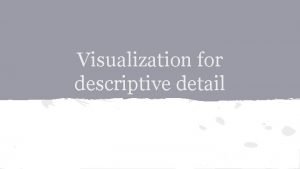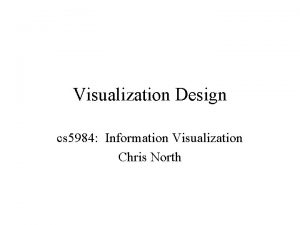Exploratory Data Analysis and Data Visualization Credits Chris

















































- Slides: 49

Exploratory Data Analysis and Data Visualization Credits: Chris. Volinsky - Columbia University 1

Outline • EDA • Visualization – – – One variable Two variables More than two variables Other types of data Dimension reduction 2

EDA and Visualization • Exploratory Data Analysis (EDA) and Visualization are very important steps in any analysis task. • get to know your data! – – – distributions (symmetric, normal, skewed) data quality problems outliers correlations and inter-relationships subsets of interest suggest functional relationships • Sometimes EDA or viz might be the goal! 3

Data Visualization – cake bakery 4

Exploratory Data Analysis (EDA) • Goal: get a general sense of the data – means, medians, quantiles, histograms, boxplots • You should always look at every variable - you will learn something! • data-driven (model-free) • Think interactive and visual – Humans are the best pattern recognizers – You can use more than 2 dimensions! • x, y, z, space, color, time…. • Especially useful in early stages of data mining – detect outliers (e. g. assess data quality) – test assumptions (e. g. normal distributions or skewed? ) – identify useful raw data & transforms (e. g. log(x)) • Bottom line: it is always well worth looking at your data! 5

Summary Statistics • not visual • sample statistics of data X – – mean: = i Xi / n mode: most common value in X median: X=sort(X), median = Xn/2 (half below, half above) quartiles of sorted X: Q 1 value = X 0. 25 n , Q 3 value = X 0. 75 n • interquartile range: value(Q 3) - value(Q 1) • range: max(X) - min(X) = Xn - X 1 – variance: 2 = i (Xi - )2 / n – skewness: i (Xi - )3 / [ ( i (Xi - )2)3/2 ] • zero if symmetric; right-skewed more common (what kind of data is right skewed? ) – number of distinct values for a variable (see unique() in R) – Don’t need to report all of thses: Bottom line…do these numbers make sense? ? ? 6

Single Variable Visualization • Histogram: – – Shows center, variability, skewness, modality, outliers, or strange patterns. Bin width and position matter Beware of real zeros 7

Issues with Histograms • For small data sets, histograms can be misleading. – Small changes in the data, bins, or anchor can deceive • For large data sets, histograms can be quite effective at illustrating general properties of the distribution. • Histograms effectively only work with 1 variable at a time – But ‘small multiples’ can be effective 8

But be careful with axes and scales! 9

Smoothed Histograms - Density Estimates • Kernel estimates smooth out the contribution of each datapoint over a local neighborhood of that point. h is the kernel width • Gaussian kernel is common: 10

Bandwidth choice is an art Usually want to try several 11

Boxplots • Shows a lot of information about a variable in one plot – – – Median IQR Outliers Range Skewness • Negatives – Overplotting – Hard to tell distributional shape – no standard implementation in software (many options for whiskers, outliers) 12

Time Series If your data has a temporal component, be sure to exploit it summer bifurcations in air travel (favor early/late) summer peaks steady growth trend New Year bumps 13

Time-Series Example 3 mean weight vs mean age for 10 k control group Scotland experiment: “ milk in kid diet better health” ? 20, 000 kids: 5 k raw, 5 k pasteurize, 10 k control (no supplement) Possible explanations: Would expect smooth weight growth plot. Visually reveals unexpected pattern (steps), not apparent from raw data table. Grow less early in year than later? No steps in height plots; so why height uniformly, weight spurts? Kids weighed in clothes: summer garb lighter than winter?

Spatial Data • If your data has a geographic component, be sure to exploit it • Data from cities/states/zip cods – easy to get lat/long • Can plot as scatterplot 15

Spatial data: choropleth Maps • Maps using color shadings to represent numerical values are called chloropleth maps • http: //elections. nytimes. com/2008/results/president/map. html 16

Two Continuous Variables • For two numeric variables, the scatterplot is the obvious choice interesting? 17

2 D Scatterplots • standard tool to display relation between 2 variables – e. g. y-axis = response, xaxis = suspected indicator • useful to answer: – x, y related? • linear • quadratic • other – variance(y) depend on x? – outliers present? interesting? 18

Scatter Plot: No apparent relationship 19

Scatter Plot: Linear relationship 20

Scatter Plot: Quadratic relationship 21

Scatter plot: Homoscedastic Why is this important in classical statistical modelling? 22

Scatter plot: Heteroscedastic variation in Y differs depending on the value of X e. g. , Y = annual tax paid, X = income 23

Two variables - continuous • Scatterplots – But can be bad with lots of data 24

Two variables - continuous • What to do for large data sets – Contour plots 25

Transparent plotting Alpha-blending: • plot( rnorm(1000), col="#0000 ff 22", pch=16, cex=3) 26

Jittering • Jittering points helps too • • plot(age, Times. Pregnant) plot(jitter(age), jitter(Times. Pregnant) 27

Displaying Two Variables • If one variable is categorical, use small multiples • Many software packages have this implemented as ‘lattice’ or ‘trellis’ packages library(‘lattice’) histogram(~Diastolic. BP | Times. Pregnant==0) 28

Two Variables - one categorical • Side by side boxplots are very effective in showing differences in a quantitative variable across factor levels – tips data • do men or women tip better – orchard sprays • measuring potency of various orchard sprays in repelling honeybees 29

Barcharts and Spineplots stacked barcharts can be used to compare continuous values across two or more categorical ones. orange=M blue=F spineplots show proportions well, but can be hard to interpret 30

More than two variables Pairwise scatterplots Can be somewhat ineffective for categorical data 31

32

Multivariate: More than two variables • Get creative! • Conditioning on variables – trellis or lattice plots – Cleveland models on human perception, all based on conditioning – Infinite possibilities • Earthquake data: – locations of 1000 seismic events of MB > 4. 0. The events occurred in a cube near Fiji since 1964 – Data collected on the severity of the earthquake 33

34

35

How many dimensions are represented here? Andrew Gelman blog 7/15/2009 36

Multivariate Vis: Parallel Coordinates Petal, a non-reproductive part of the flower Sepal, a non-reproductive part of the flower The famous iris data! 37

Parallel Coordinates Sepal Length 5. 1 38

Parallel Coordinates: 2 D Sepal Length Sepal Width 3. 5 5. 1 39

Parallel Coordinates: 4 D Sepal Length Sepal Width Petal length Petal Width 3. 5 5. 1 40 1. 4 0. 2

Parallel Visualization of Iris data 3. 5 5. 1 1. 4 41 0. 2

Multivariate: Parallel coordinates Alpha blending can be effective Courtesy Unwin, Theus, Hofmann 42

Parallel coordinates • Useful in an interactive setting 43

Networks and Graphs • Visualizing networks is helpful, even if is not obvious that a network exists 44

Network Visualization • Graphviz (open source software) is a nice layout tool for big and small graphs 45

What’s missing? • pie charts – – very popular good for showing simple relations of proportions Human perception not good at comparing arcs barplots, histograms usually better (but less pretty) • 3 D – – nice to be able to show three dimensions hard to do well often done poorly 3 d best shown through “spinning” in 2 D • uses various types of projecting into 2 D • http: //www. stat. tamu. edu/~west/bradley/ 46

Worst graphic in the world? 47

Dimension Reduction • One way to visualize high dimensional data is to reduce it to 2 or 3 dimensions – Variable selection • e. g. stepwise – Principle Components • find linear projection onto p-space with maximal variance – Multi-dimensional scaling • takes a matrix of (dis)similarities and embeds the points in p-dimensional space to retain those similarities More on this in next Topic 48

Visualization done right • Hans Rosling @ TED • http: //www. youtube. com/watch? v=jbk. SRLYSo jo 49
 Exploratory data analysis lecture notes
Exploratory data analysis lecture notes Eda.a
Eda.a Task abstraction example
Task abstraction example Visualization analysis and design tamara munzner
Visualization analysis and design tamara munzner Signal analysis and visualization
Signal analysis and visualization Exploratory factor analysis
Exploratory factor analysis Exploratory cluster analysis
Exploratory cluster analysis Combining new markets and historic tax credits
Combining new markets and historic tax credits The uniform customs and practice for documentary credits
The uniform customs and practice for documentary credits Debits and credits t chart
Debits and credits t chart Debits and credits cheat sheet
Debits and credits cheat sheet Before and after data visualization
Before and after data visualization Criteria for evaluating secondary data
Criteria for evaluating secondary data Exploratory research secondary data
Exploratory research secondary data Market basket analysis visualization
Market basket analysis visualization Visualization analysis & design
Visualization analysis & design Georgijev financial group
Georgijev financial group Transfer center vcu
Transfer center vcu Historic tax credits 101
Historic tax credits 101 What is ects
What is ects Avrupa kredi transfer sistemi nedir
Avrupa kredi transfer sistemi nedir Uncc transfer
Uncc transfer Credits medical definition
Credits medical definition New market tax credits st louis
New market tax credits st louis Scu transfer credits
Scu transfer credits Consortium agreement utep
Consortium agreement utep Credit frame
Credit frame Episd credits
Episd credits Edward scissorhands opening scene analysis
Edward scissorhands opening scene analysis Tufts university liberal arts
Tufts university liberal arts The walking dead opening credits
The walking dead opening credits T-accounts debits & credits simulation
T-accounts debits & credits simulation Credits clip art
Credits clip art Imagine there is a bank account that credits you
Imagine there is a bank account that credits you New market tax credits 101
New market tax credits 101 Michigan historic preservation tax credit
Michigan historic preservation tax credit The plaza apartments toledo ohio
The plaza apartments toledo ohio Hpe knowledge credits
Hpe knowledge credits Mobility credits
Mobility credits Ocean data visualization
Ocean data visualization Vli demo tool
Vli demo tool Google visualization api query language
Google visualization api query language Data visualization rules of thumb
Data visualization rules of thumb Bad graphs
Bad graphs Flask data visualization
Flask data visualization Data visualization meetup
Data visualization meetup Data visualization sketch
Data visualization sketch Hitlantis
Hitlantis Baby name wizard voyager
Baby name wizard voyager Data visualization lecture
Data visualization lecture

